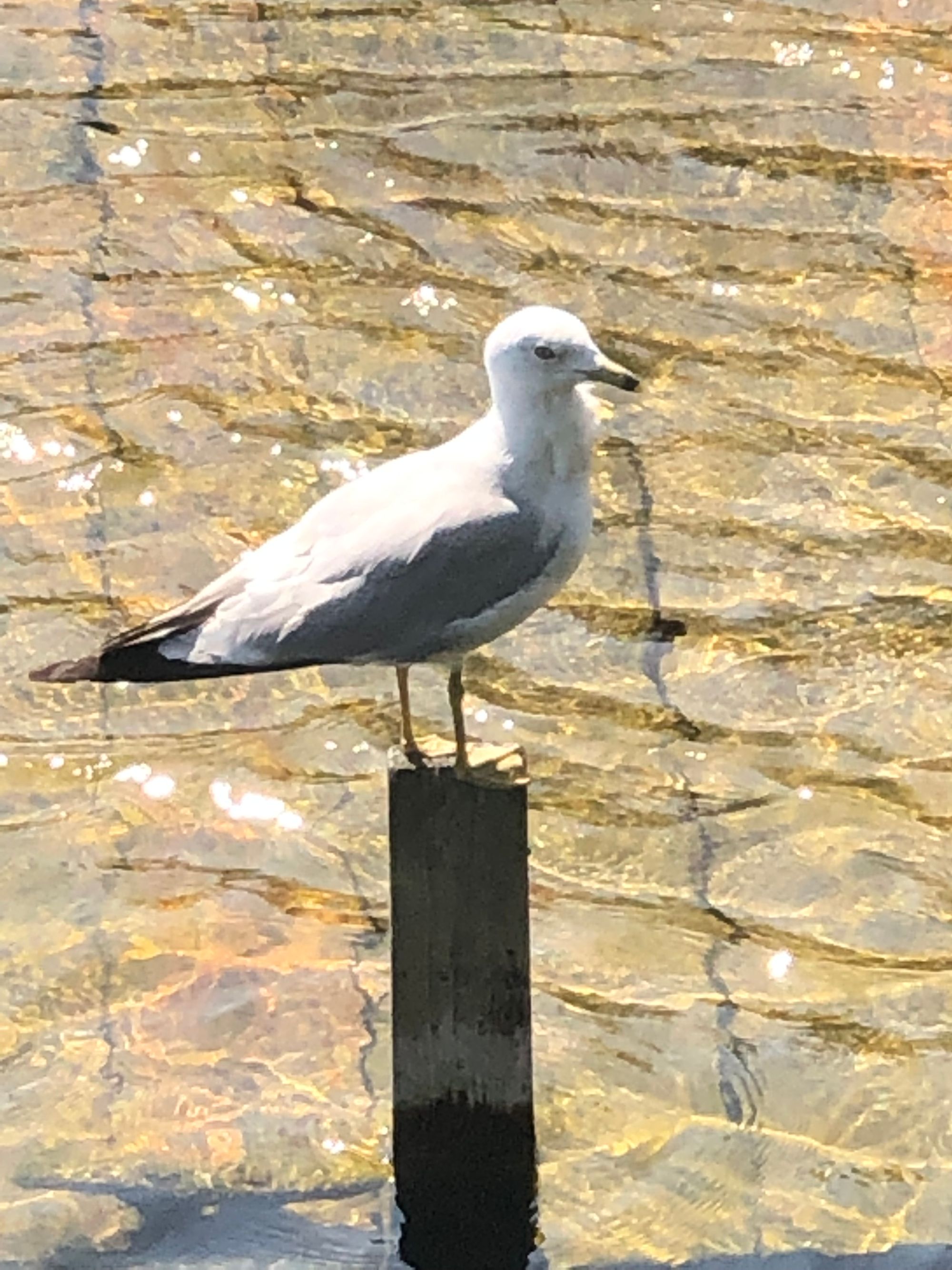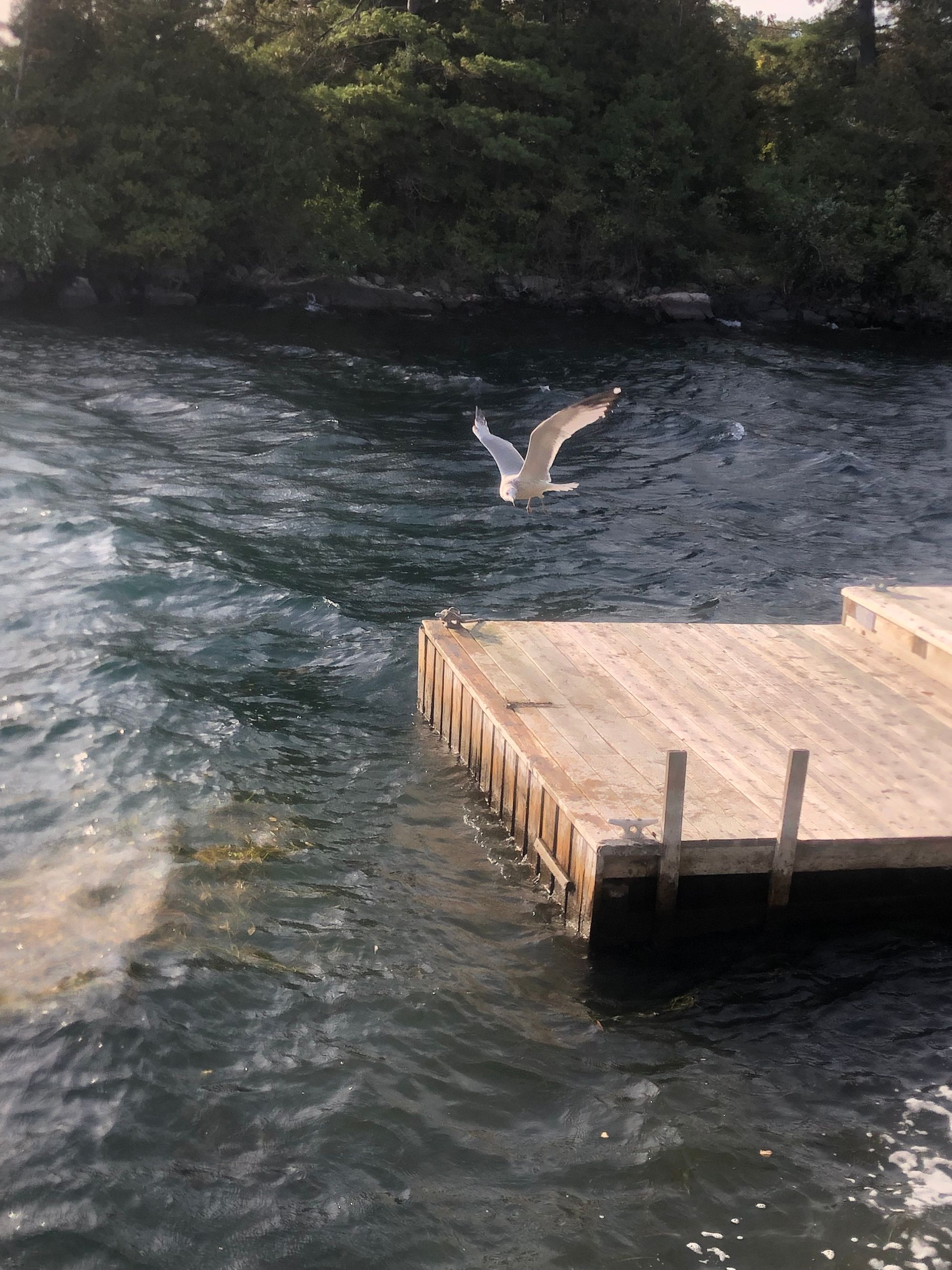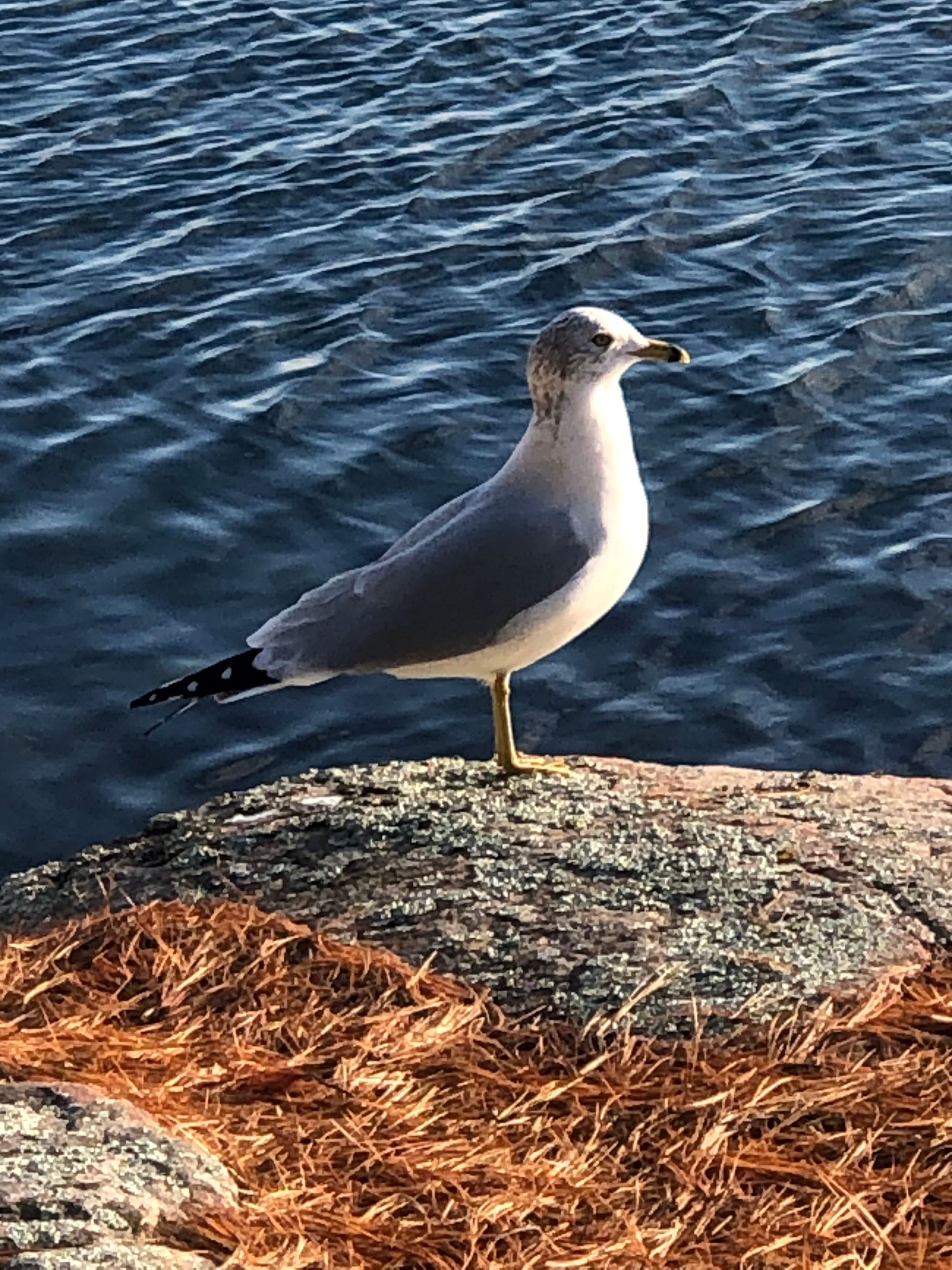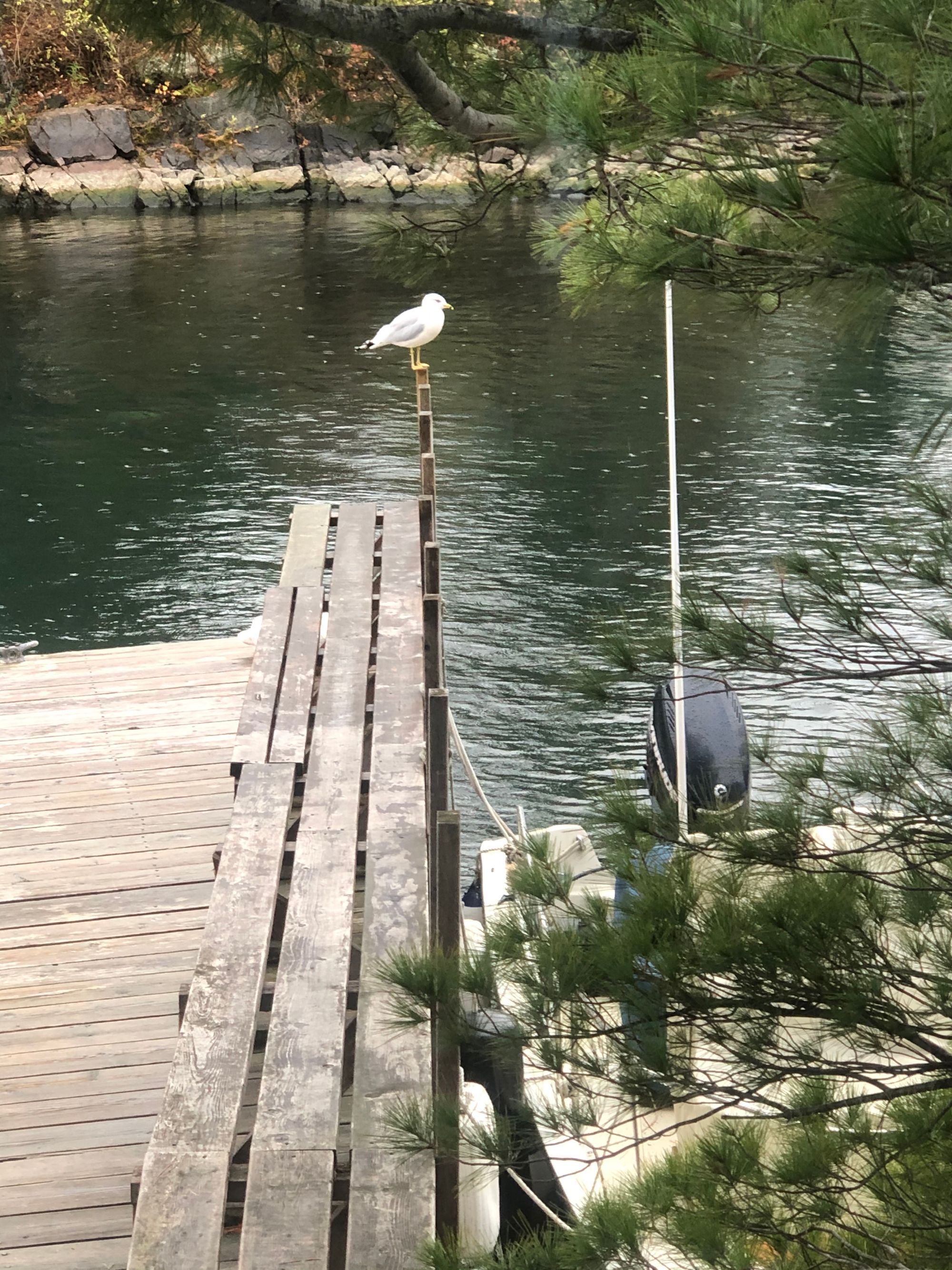Encounters with wildlife are among the most exciting, intriguing, and memorable happenings in our northern summers. Although mostly brief and singular, they can burst upon us with lasting impact.
Most people think that there is little chance of, and no gain to come from, a relationship with the descendants of the dinosaurs. Our experience of recent summers has taught us differently.

2017
It began one bright, blue, late summer morning in 2017, a year with a highwater level that was receding as fall approached. At breakfast, we noticed a ring-billed gull perched on a newly reappearing rock just off our lower dock. When breakfast was over, a piece of toast remained untouched on the table. My dear friend, JBJ, arose, grabbed it, sauntered out on the high rock above the water, and began throwing morsels to the gull. It flew over, swooped down, and gobbled the crumbs on the water. As she threw the crumbs, she spoke to the gull. The next morning, the seagull was back. She went out, fed it again, speaking as before, and then, again, on a third morning.

JBJ was not there the next morning, when I went out at breakfast, talking, and also throwing pieces of bread. The seagull came over, with similar results. Later, it was JBJ who named our friend “Jonathan,” seeing in him a semblance to the spirit of that fictive soul, Jonathan Livingston Seagull.
As the weeks passed, Jonathan came in closer and closer, and even flew off his rock as soon as we opened the door before shouting his name. Although others might think we were wasting our time, we continued to feed, to watch, and to learn.
It’s not just that we had made a friend. Jonathan would cry loudly at unexpected times while sitting on his rock. Unsure why at first, we watched, and came to see that he would let out a particular shrill cry when he saw other gulls. And they would keep their distance. In fact, he was keeping them away, and keeping us for himself!

It is difficult to explain how one could actually appreciate a seagull. After all, most people think that one seagull is just like another. When a seagull approaches a human offering it food, it is, usually, joined by others, creating a feeding frenzy that obscures individual identity. However, Jonathan had singled us out, just as much as we had singled him out from the crowd! He was protecting us from the confusion and insensitivity of a mass feeding event, and all the unpleasantness it can involve.
Jonathan disappeared by the end of October, and we thought we might not see him again.

2018
The summer of 2018 brought normal water levels and Jonathan’s rock was mostly dry on top. However, it was not until late June that a gull appeared and showed a high degree of familiarity by flying in and alighting on our rock. We fed him regularly, and he acted just as Jonathan had done the prior year.
One day, in mid-summer, there came another seemingly smaller gull to accompany Jonathan on a neighboring rock. It was an immature gull, with a mottled appearance: a mix of black, gray and white, not the pure colors of Jonathan. This gull came with Jonathan to pick up crumbs of bread, but was shy, and at first, inclined to defer to his senior.

We named the new gull “Sidekick.” Likely born in the spring, by summer he had become the avian equivalent of a human teenager. It was not long before Sidekick joined Jonathan in crying at and scaring off the other gulls that flew by, sometimes hundreds of meters away.
As the weeks passed, Sidekick became more and more sure of himself, no longer backing off to allow Jonathan to grab the bready morsels. He became accustomed to us, and sometimes paddled right up under the cliff on which we stood. Then, he began to beat Jonathan to snippets of bread and seemed to become more and more aggressive.

It soon became clear that Sidekick was in fact fighting for his food, and would even body-check Jonathan in the quest for bread. Still, Jonathan continued to come to his rock, and at first, seemed untroubled by the fact that Sidekick was routinely getting more bread than he.
Then came the day when all that changed: some other gulls defied the warning cries of Jonathan and Sidekick, lured beyond caution at the prospect of free food. Sidekick swooped up and around, chasing the intruders, and pecked at their tail feathers. Sidekick had become a bully.
His bullying soon turned into simple brutality, as he took up chasing Jonathan, even lunging at him, as if to peck him. Finally, in the late summer, we saw Sidekick pluck out some of Jonathan’s tail feathers. It was a benefit for us, to be able to identify Jonathan with certainty. However, we were not happy to see in Sidekick the bullying that reminded us of indecent human brutes and bullies!
It was early November when both of our friends left our little island haven, even before we had. We wondered where they would go for the winter, how they would survive it, and whether we would see them again.

We were fascinated to learn about the breeding habits of seagulls, and the times that they would likely come our way, and stay for a lengthy visit. Breeding gulls are usually occupied with their families in May and early June, so are not likely to visit us until their parental duties are complete. The gulls born in the spring are not likely to be seen flying about until some time in July. The more mature, but still non-breeding gulls, which are one to two years old, have most of the year off, free to spend more time flying about and looking for handouts.
2019
The winter of 2019 had passed, and we were back on the island, with record high water levels for the second time in three years, covering Jonathan’s rock and our docks. I put up our catwalk on the dock again, with posts about four feet apart.
We were keenly aware of gulls in the vicinity but saw none that seemed familiar, so we didn’t try to feed any. Once spring had passed, we gave up hope that we would meet one of our friends again, until that unsuspecting, bright, sunny morning of July 10th. We looked out to see a big, beautiful, almost mature, and clearly marked, ring-necked gull perched on the most distant post of our catwalk. Was this an old friend?

We both ran out onto the high rock and spoke to the gull, throwing bread bits down to the water. Without hesitation, the gull flew over, landed, and began to eat! Careful examination with our binoculars, and reference to our Peterson’s bird guide, revealed that this gull had small speckles on the sides of its neck, proving that he was a young adult, non-breeding, and therefore could not be Jonathan. We were sad not to see him again, but more than pleased that at least one old friend had returned for another summer!
Sidekick stayed with us throughout the summer, often perching on a catwalk post for attention, and regularly being rewarded with a feeding. He also perched on our outboard motor, never once defiling it, and was rewarded as he wished. We, on the other hand, soon witnessed a feeding that we had never expected, and had not known was possible.

One morning, while Sidekick was scarfing up morsels of bread on the water around him, we suddenly saw something we had never seen before: a creature with the appearance of a snake came to the surface next to him. No sooner had we seen it, then Sidekick grabbed it, threw it into the air, caught it, and then flew with it over to some nearby rocks. He pecked at the thing repeatedly, throwing it in the air, and banging it on the rocks, giving us time to grab our binoculars and study the phenomenon in detail.
We watched carefully and determined that it was an eel. It was about 16 inches long, the length of Sidekick from beak to tail end, and was certainly a native species of eel. After a few minutes, Sidekick threw it up in the air, caught its head, and attempted to swallow it. At first, he failed. But he tried over and over, until he finally managed to put its head deep into his gullet and then simply eased the rest of it all the way down! I was amazed, but JBJ was repulsed!
Sidekick did not come for his morning snack the next day, but returned a day later, acting as if he had not eaten in a week! He was as aggressive as ever toward other gulls, and eager to nab every morsel of bread that we released. We debated whether we were responsible for Sidekick’s bullying, or whether it was just his nature. When we left in November, we once again wondered what the next summer might bring.
2020
Regulations to stop COVID in its tracks barred me from entering Canada in 2020. It was mid-summer, with normal water levels, when JBJ, her brother, and some very good friends cruised over to our little island to help take care of it. And, surprisingly, Sidekick had returned!

Upon their approach to the dock in late July, JBJ did not see any gulls in the area. However, Sidekick was on her mind. After landing and securing the boat, she walked directly up to the high rock, and called out for him. At once, surprising both JBJ and her brother, Sidekick flew in, seemingly from nowhere, and landed right below her! She scrambled to produce a crust of bread, and promptly fed our old friend. She returned to the island every few weeks, and always found Sidekick in attendance. Unfortunately, he was still a bully, crying loudly when other gulls came within sight, then chasing and pecking hard at them if they came in for a few crumbs. JBJ continued to feel torn between appreciation for Sidekick’s attention and protection on the one hand, but on the other, disapprobation of his anti-social behavior!
It was well into November when there came a revelation while watching a raft of mergansers feeding on a school of fish. There was a gull among them, and further inspection confirmed that it was none other than Sidekick! He swam in between them, turning about and occasionally dipping his head down into the water as if to be looking for a fish, just like a duck. And they were unconcerned by his company!
Apparently, Sidekick had transcended his rift with the gulls, who, presumably, must have shunned him. He was developing a new identity: that of a merganser! JBJ then blurted out, “He’s just another wannabe!”

We pondered whether, if he flew south with the mergansers, he might wonder about the company he kept. He could have the opportunity to rise above the bullying behavior and become a respectable member of a flock of fine feathered friends. Hopefully, he would develop an understanding of how to practice the Golden Rule: Do unto others as you would have them do unto you. Or, we wonder to this day, had he become as stubborn, arrogant, and intransigent as any other bully?
We were never able to identify Sidekick again but have made friends with other gulls since that time. We have repeatedly witnessed further remarkable and surprising behaviors that reveal aspects of seagull personality that we had never suspected!
By Raymond Pfeiffer, The Punts, Lake Fleet
Raymond Pfeiffer, an Emeritus Professor of Philosophy, relishes his time on The Punts Islands with his dear friend, Judith Bedford-Jones, alias JBJ, a retired nurse and lawyer, who also enjoys time on her family island, Mudlunta.
[Note: All photographs are courtesy of the author, ©2023]
Posted in: Volume 18, Issue 3, March 2023, Nature
Please click here if you are unable to post your comment.
